
Ultimate Galapagos: Central Islands (Grand Daphne) Itinerary



Bienvenidos! Welcome to Ecuador. Your adventure begins in Quito – Ecuador’s sprawling capital city. You’ll have a welcome meeting at 5 or 6 pm tonight to meet your local leader and small group of fellow travellers. If you arrive early, maybe check out the city at your own pace – head to the Old Town and pick one (or more) of the 30 churches to explore. After your meeting, you’ll head to a small, local restaurant for dinner with your group. Take in the aromas and fresh flavours of the traditional Ecuadorian cuisine – think locroc (traditional potato soup) or quinoa, pork and vegetable dishes cooked with herbs, lemongrass and rich sauces, all sourced from local farms.
You have a very early start this morning (maybe as early as 4 am, depending on flight times) as you head into the Galapagos. Transfer to Mariscal Sucre International Airport (Quito Airport), with a boxed breakfast on the way. When you arrive, you’ll meet your naturalist guide in the arrival hall, then be transferred to your boat – Le Grande Daphne. Meet the crew, settle in and have some lunch with your fellow travellers. Try on the snorkelling gear before your first snorkelling session, then sail to Las Bachas, where the soft sand made of decomposed coral is a nesting site for the Pacific green turtle. Marine iguanas are also commonly spotted along the beach. The rocks make for excellent snorkelling and are populated by Sally Lightfoot crabs. A saltwater lagoon just near the beach is home to flamingo and whimbrel and you might also see a great blue heron. Remnants of a floating pier, a testimony to the US presence in the Galapagos during World War II, can also be seen.
Today, you’ll sail from Las Bachas to Isla Rabida, known for its spectacular red sand beaches, caused by the high content of iron in the sand which rusts to form the unusual shade. From the shore, follow today’s hiking trail to a lagoon that’s one of the best spots in the Galapagos to see flamingos. Keep an eye out for nesting pelicans, pintail ducks, marine iguanas and sea lions, too. Check out a vast opuntia cactus forest, hinting at the previous habitation of land iguanas, Galapagos hawks, mockingbirds, doves, finches and lava lizards. After, you can opt to go snorkelling to seek out the resident sea stars, damsels, gobbies and surgeon fish. In the afternoon, head to Albemarle on the northeast side of Isabela Island. Covered in mangroves, the bay is home to sea turtles, sea lions, penguins and flightless cormorants who feed on the algae and fish here. Another fantastic location for snorkelling, you may like to have a look beneath the water’s surface in search of sea turtles and flightless cormorants.
Sail overnight from Punta Albermarle around to the western shores of Isla Isabela. Wake up near Tagus Cove, where pirates and whalers used to collect tortoises for their travels. Maybe go snorkelling here or check out the graffiti on the walls (the oldest of which is from 1836!). Look out for flightless cormorants, blue-footed boobies, a variety of waterfowl and the most northerly penguins in the world. You’ll then walk to a lookout point for a stunning view of the north of Isabela Island and Volcan Wolf (Wolf Volcano). Later, visit Bahia Urbina on the west of Isabela Island to see the bay’s diverse and colourful plant life, which attracts many different insects. The site also features a short hike inland, where giant tortoises can be spotted among the bushes. You may also see land iguanas, which often nest in the middle of the trail. Flycatchers, Darwin’s finches and mockingbirds are common on the ground and in the trees.
Today, visit Punta Espinosa – a narrow ledge of lava and sand extending from the base of La Cumbre volcano. Walk around the peninsula to see the lava cacti, marine iguanas, barking sea lions, tiny penguins and Sally Lightfoot crabs. Keep an eye out for the Galapagos hawk, too, hunting in the treetops. Then, dive into the clear waters for snorkelling, looking out for the resident turtles and sea lions. In the afternoon, head to Punta Vicente Roca and take a Zodiac ride to see the abundant wildlife here. This spot is also one of the best snorkelling spots in the archipelago! The route takes you along the cliffs and allows you to explore two shallow underwater caves. The primitive and unaggressive bullhead shark, known locally as the Port Jackson shark, is often seen here sharing its space with red-lipped batfish, frogfish, Pacific seahorses, the endemic Camotillo, schools of barracuda and brown-stripped snappers.
Sail to Puerto Egas – a black-sand beach on the west side of James Bay, northwest of Isla Santiago. Home to incredible volcanic tuff formations, you’ll stroll along the beach with the native marine iguanas, pelicans, finches, mockingbirds, oystercatchers, Galapagos sea lions and Galapagos fur seals. You can see the tidal pools, formed from ancient lava flow, providing a home for sponges, snails, hermit crabs, barnacles and fish. You might also end up snorkelling with a Galapagos fur seal – they’re always looking for a friend! In the afternoon, travel to the northwest side of Santiago Island where you’ll find Caleta Bucanero – named after the pirates and buccaneers who once found shelter in the bay. Here, you can go snorkelling and take a dinghy ride to look for blue-footed boobies, pelicans and nocturnal seagulls nesting in the cliffs.
Wake up in Bartolome Island – a volcanic landscape full of spatter cones and lava flows, home to Galapagos penguins and lava lizards. Put on your walking shoes and climb up 360 wooden steps to the summit, where an amazing view of Pinnacle Rock awaits. This is one of the most photographed sights in the Galapagos! Hike to the top of a once-active volcano and enjoy the views across to Bahia Sullivan on nearby Isla Santiago. If you’re in luck, you might see the Galapagos hawk. There’s also the chance to go snorkelling among the colourful marine life. In the afternoon, travel to the small island of Sombrero Chino, found on the southeast side of Santiago Island. With sandy beaches and a volcanic landscape, this is a great spot to hike and look out for the sea lions and penguins that rest here. Or, you can snorkel in search of reef sharks and sea turtles.
Wake up in North Seymour – one of the most visited islands of the Galapagos. Take a morning walk around the island to see blue-footed boobies and swallow-tailed gulls. Boobies and frigates have an interesting relationship, sharing the same nesting area on North Seymour. Blue-footed boobies nest on the ground while the frigate birds nest just above them in the saltbushes. As you walk, look out for land iguanas, marine iguanas, Galapagos sea lions and the endemic incense tree. After, cool off and go snorkelling to see the variety of fish and white-tipped reef sharks, rays and sea lions here. Later, travel to Isla Santa Cruz – the second largest island in the Galapagos. Visit the Charles Darwin Research Station – undertaking vital conservation work, the station also makes for interesting exploration and offers the best opportunities for close encounters with giant tortoises. You may also see baby tortoises!
Flights to the mainland depart mid-morning, so it’s an early start for your last morning on the islands today. You’ll visit the Santa Cruz Highlands first, travelling through the agricultural region and into the misty forests, where you can see the dome-shaped giant tortoises in the wild. Look out for different species of Darwin finches and the world-famous woodpecker and warbler finches. Then, it’s time to bid farewell to the archipelago and head to the airport for your mid-morning flight back to Quito for the last night of the trip. You'll arrive at about 4 pm, taking a transfer back to your hotel. You might want to head out with your fellow travellers for dinner tonight, toasting to an incredible, wildlife-filled adventure.
There are no activities planned for today, and your adventure finishes after breakfast this morning. Of course, that doesn’t mean your adventure has to end! Why not stay on in Quito for a few days and discover the charms of the city. If you need help booking extra accommodation, just speak to your booking agent ahead of time.

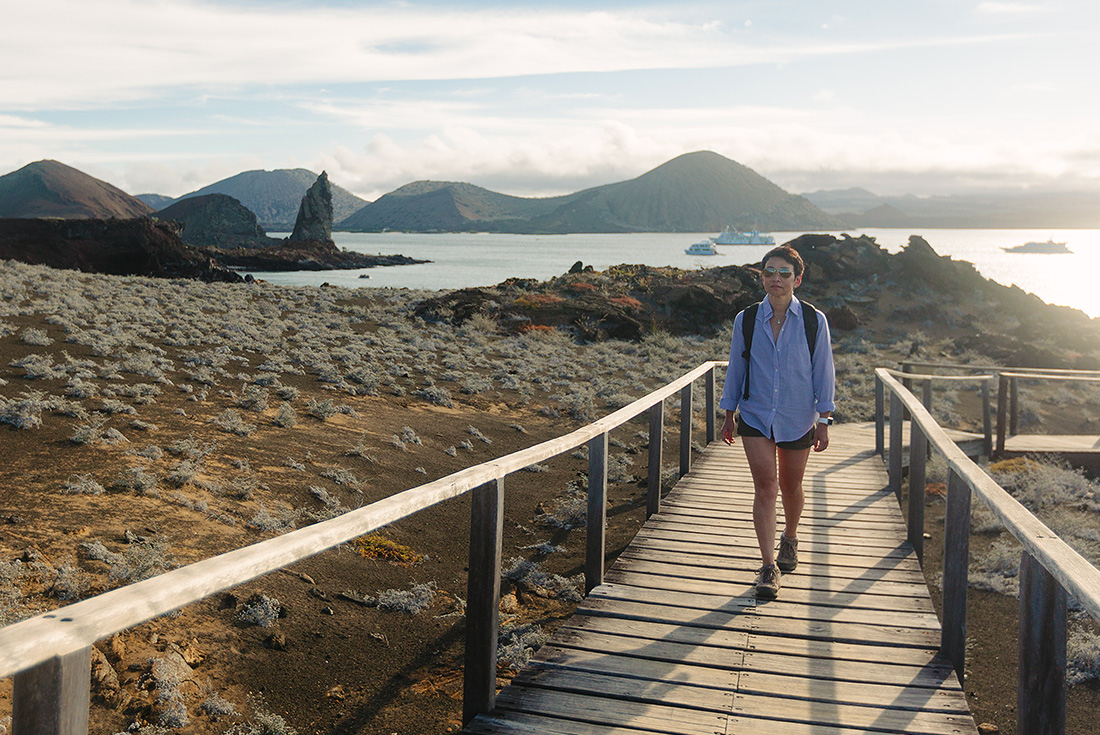
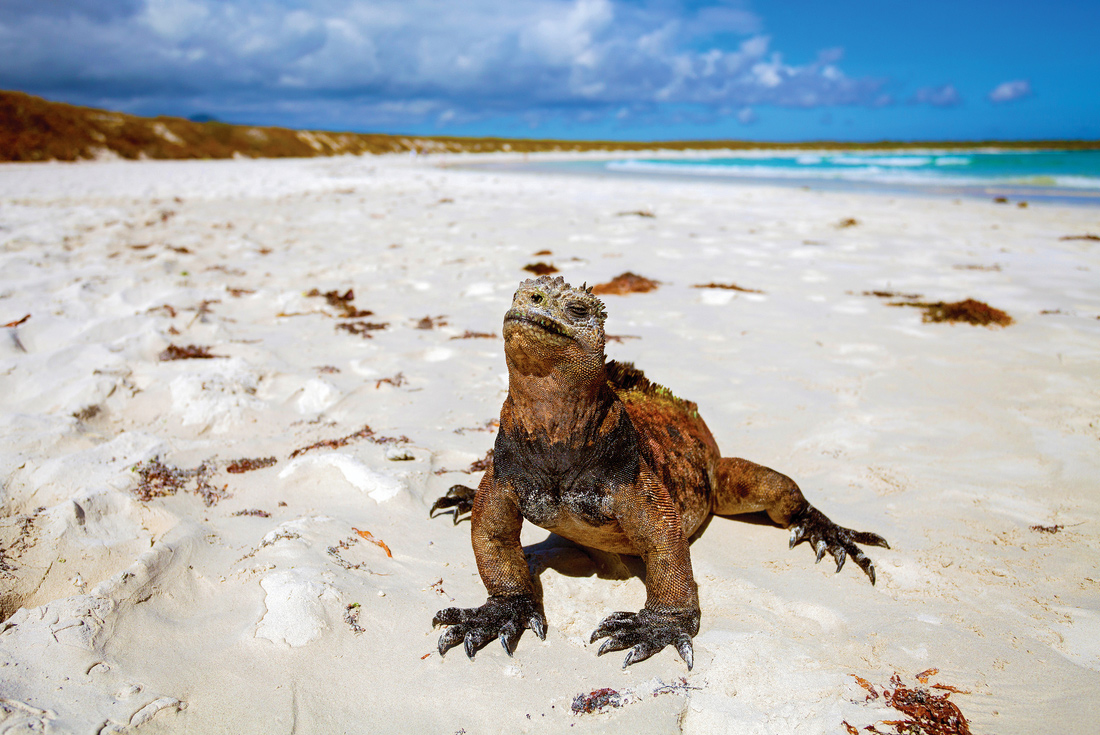
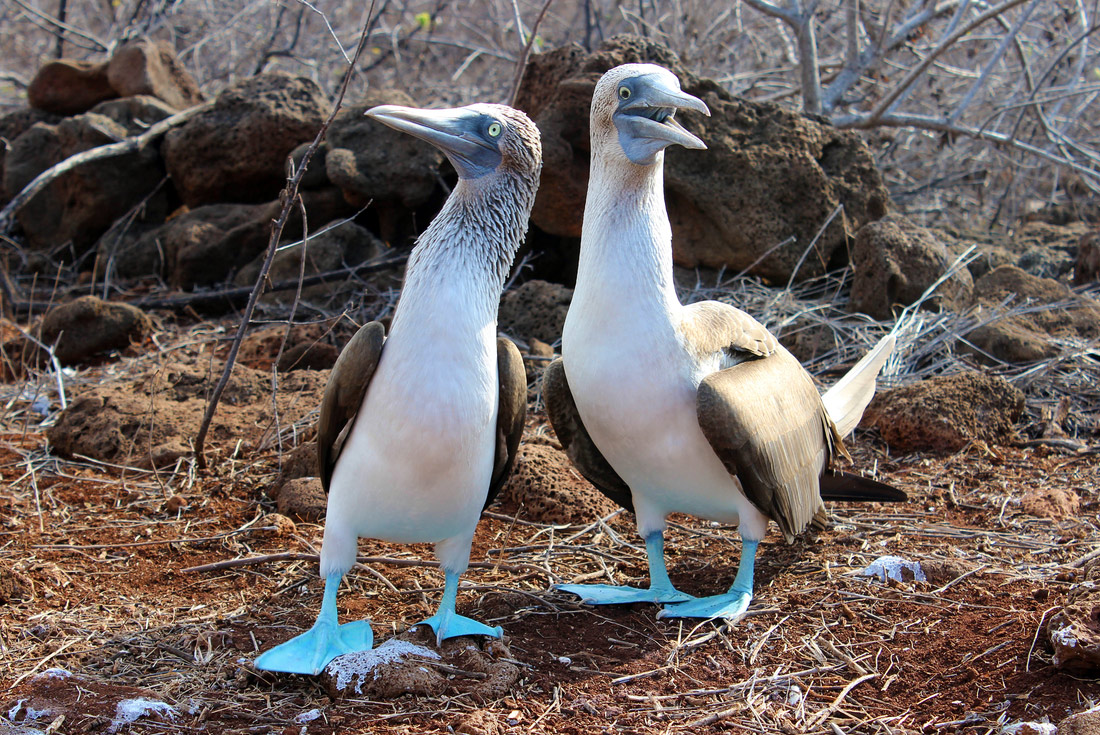
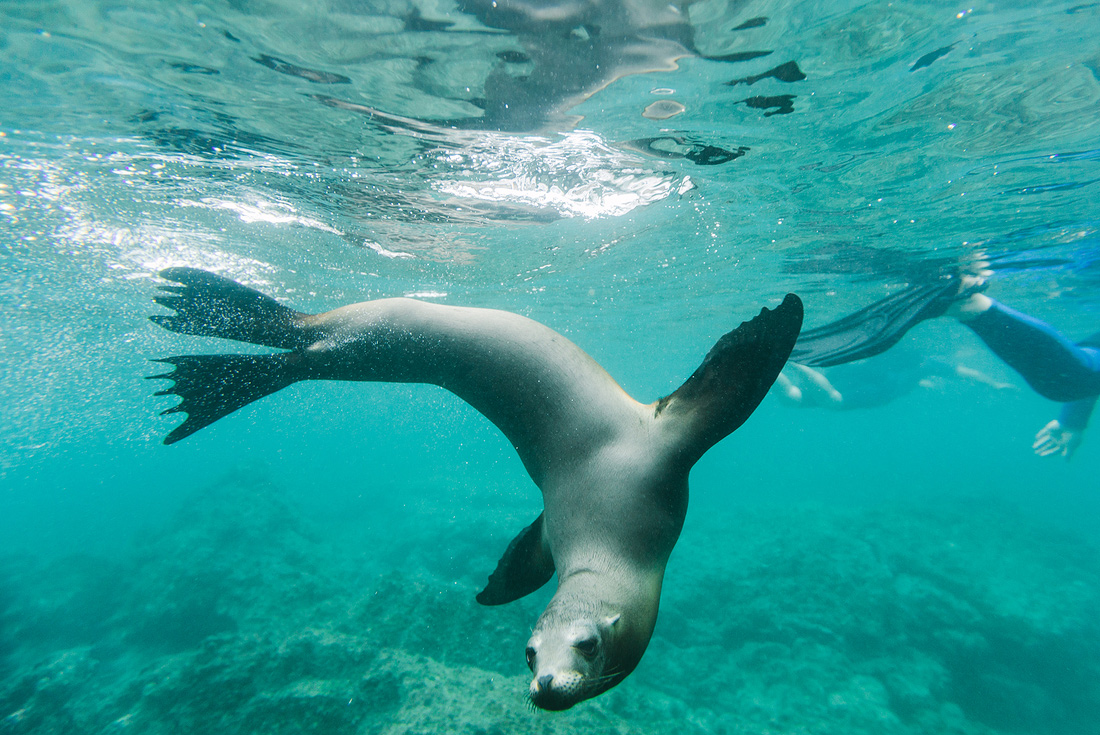

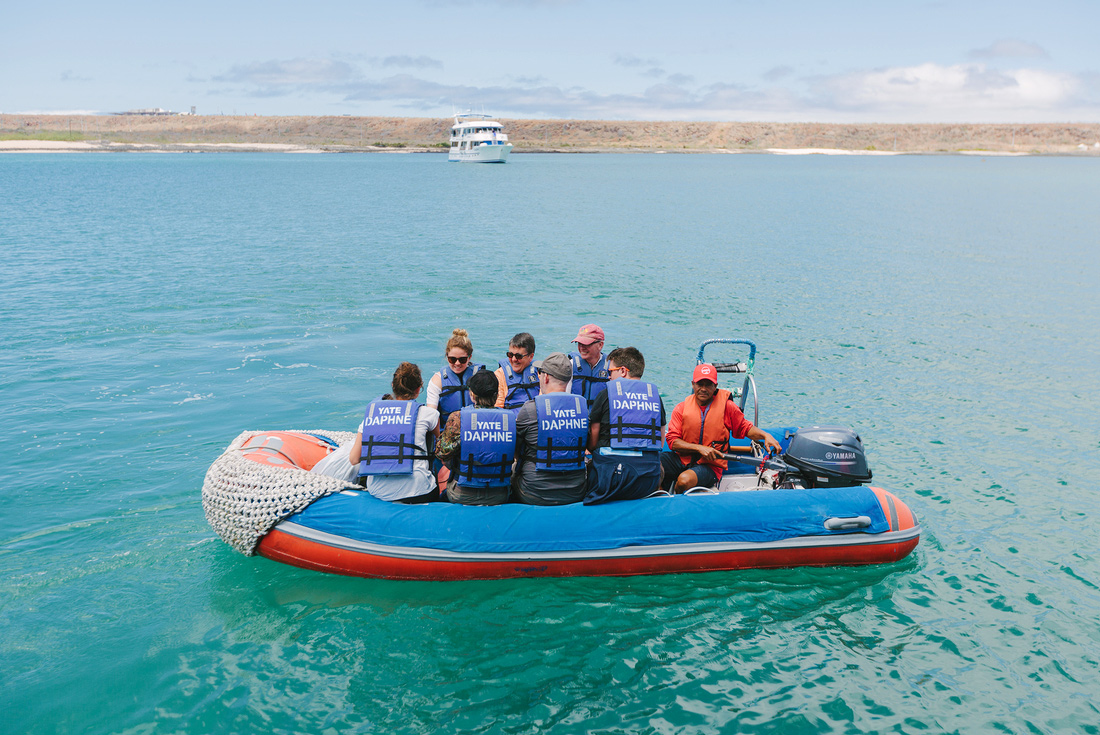

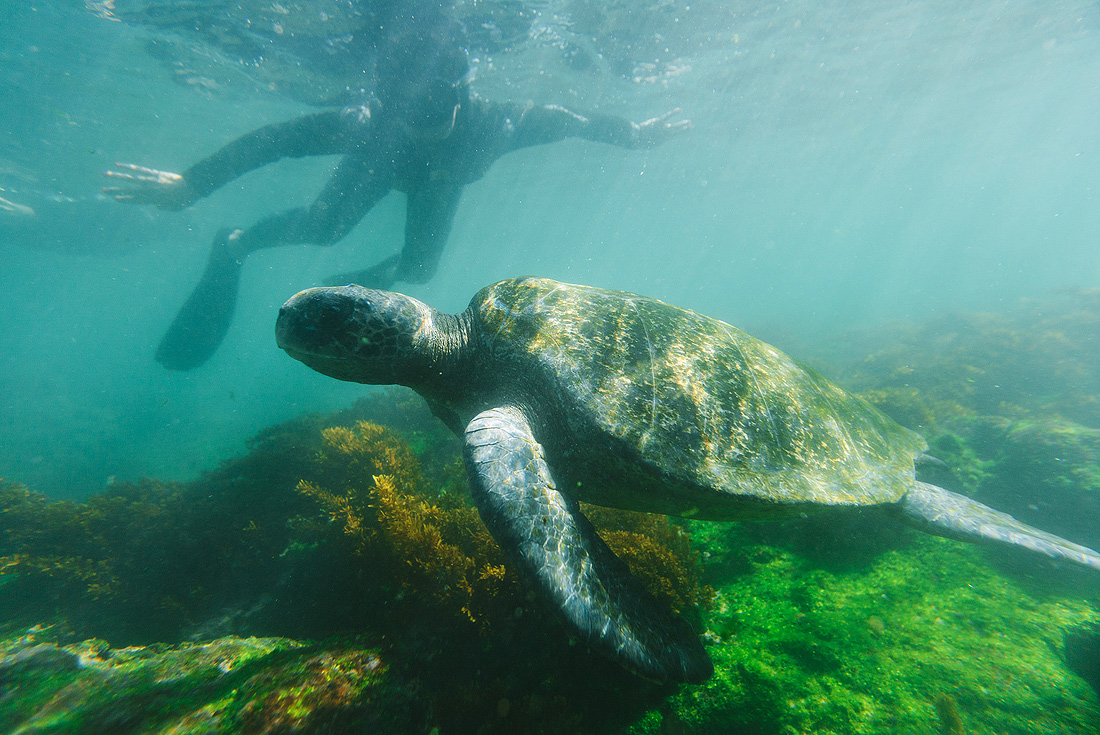
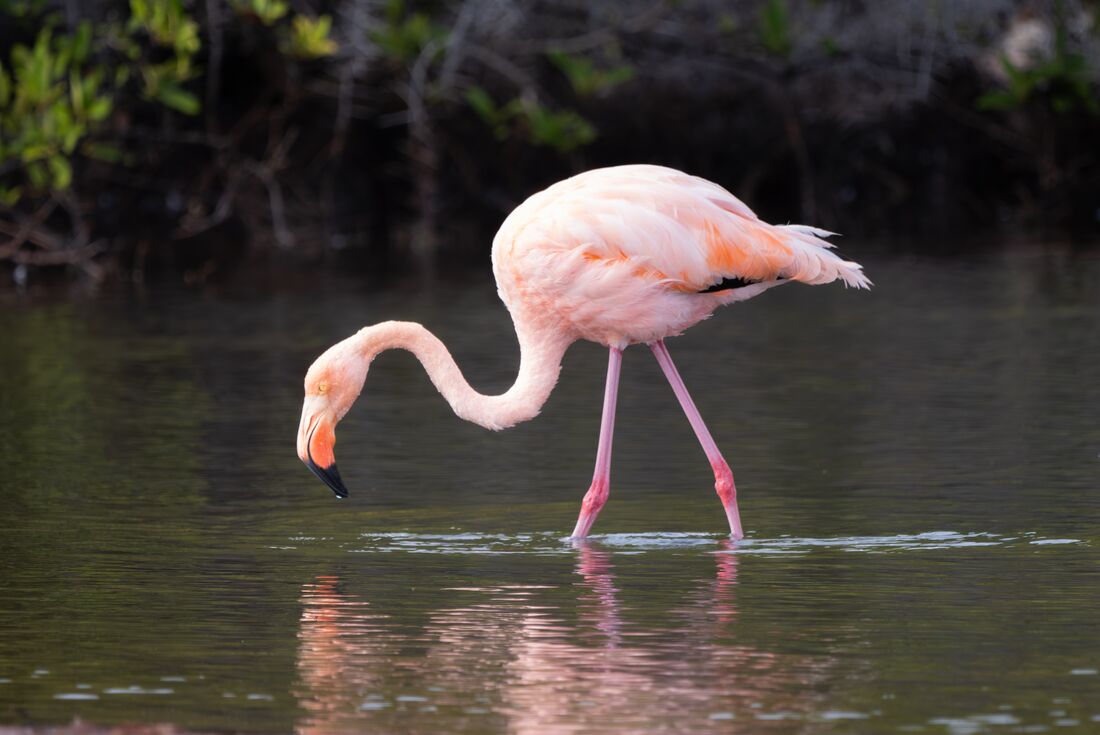
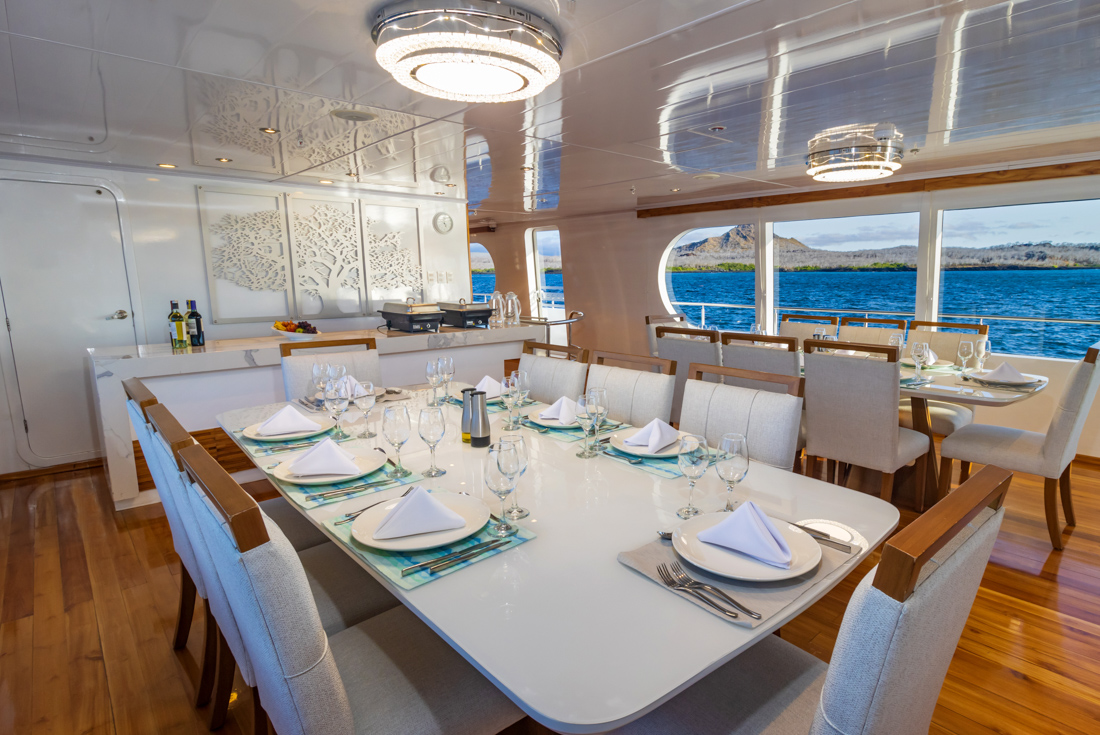
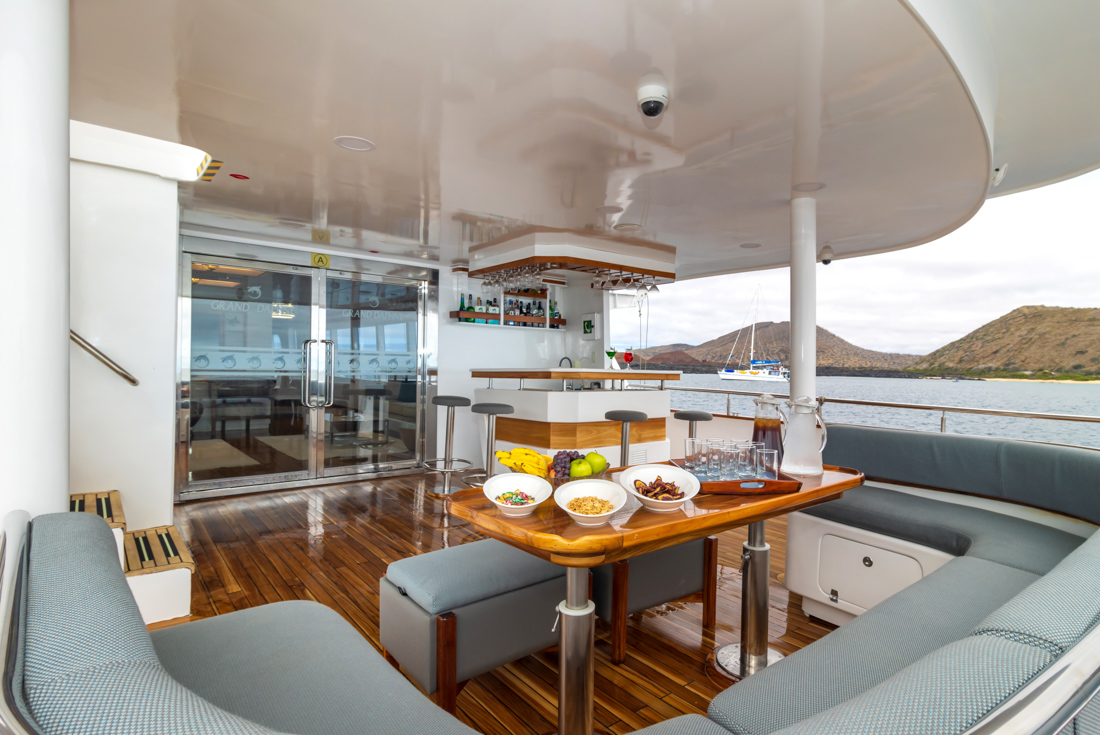
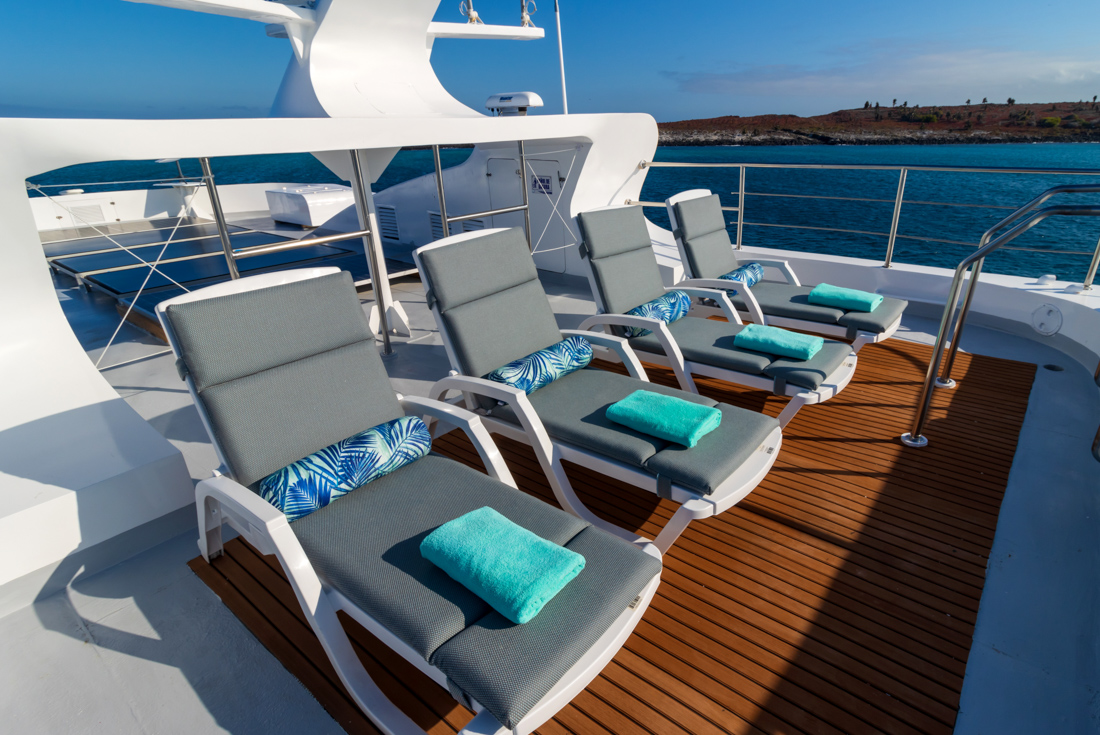
Isla Santa Cruz - Bachas Beach Walk (1 hour) - Wet Landing
Isla Santa Cruz - Bachas Beach Snorkel (1 hour) - Wet Landing
Isla Rabida - Walk and Snorkel from the beach (2 hours) - Wet Landing
Isla Isabela - Punta Albermarle - Snorkelling (1 hour)- Dry Landing
Isla Isabela - Tagus Cove - Walk (1.45 hours) - Dry Landing
Isla Isabela - Tagus Cove - Snorkel (1 hour)
Isla Isabela - Urbina Bay - Snorkel (1 hour)
Isla Isabela - Urbina Bay - Walk (1.5 hours) - Wet Landing
Isla Fernandina - Punta Vicente Roca Snorkelling (1 hour) Dry Landing
Isla Fernandina - Punta Vicente Roca - Panga Ray boat tour (30 mins)
Isla Fernandina - Punta Espinosa - Snorkel (1 hour)
Isla Fernandina - Punta Espinosa - Walk (2 hours) - Dry Landing
Isla Santiago - Puerto Egas - Snorkelling (1 hour)
Isla Santiago - Puerto Egas - Walk (1.45 hours) - Wet Landing
Isla Santiago - Caleta Buccanero - Panga boat tour (1 hour)
Isla Santiago - Caleta Buccanero - Snorkelling (1 hour)
Isla Bartolome - Snorkelling (1.5 hours)
Isla Bartolome - Walk (1.5 hours) - Dry Landing
Isla Sombrero Chino - Snorkelling (1.5 hours) Wet Landing
Isla Sombrero chino - Walk (1.5 hours) Wet Landing
Isla North Seymour - Snorkelling (1 hours)
Isla North Seymour - Walk (2 hours) - Dry Landing
Isla Santa Cruz - Charles Darwin Research Station (1.5 hours) - Dry Landing
Isla Santa Cruz - Highlands Visit (1 hour) - Dry Landing
Hop aboard your vessel, Le Grande Daphne, and sail through the naturally beautiful landscapes of the Galapagos, all with a handy naturalist guide by your side.
Hike, snorkel, sleep, repeat – this isn’t your average adventure cruise! You’ll have daily walks and hikes followed by snorkelling excursions to spot marine life and corals – the best way to cool off.
Explore the remote west coast of Isabela on a small panga boat and venture to the far-west Fernandina – home of the highest density of marine iguanas.
Encounter the unique Galapagos wildlife in their natural habitat, from giant blue-footed and masked boobies, pelicans and frigate birds to iguanas, sea lions and turtles.
Walk varied landscapes among towering cacti, rocky cliffs, red-sand beaches, volcanic grounds and immersive sea coves.
NH Collection Quito Royal, Cordero 444 - Avenida 12 de Octubre , Quito, 170143, ECUADOR, Phone: 593 22233333
NH Collection Quito Royal, Cordero 444 - Avenida 12 de Octubre , Quito, 170143, ECUADOR, Phone: 593 22233333
GALAPAGOS PARK, TRANSIT CARD
Before checking in for the flight from Quito to the Galapagos, there is a US$20 transit fee that needs to be paid. On arrival in the islands you must pay the US$200 national park fee to enter Galapagos National Park. This applies to everyone aged 13 years and above. For children aged 12 the fee will be USD100.
If your voyage visits Isabela Island, there is also a US$10 fee to be paid on arrival at the island.
ARRIVAL TRANSFER:
This tour includes a complimentary arrival transfer in Quito. Please advise flight details 30 days prior to travel so that the transfer can be organised.
PASSPORT DETAILS:
When booking, please make sure that your name is spelt correctly, and that you book using the name in your passport (particularly if you are recently married). If you are issued a new passport with a different number between the time that you book and the time you travel, please take both the old and new passports with you.
DIETARY REQUIREMENTS:
Should you have a special diet requirement (for example vegetarian, celiac, vegan, severe food allergies) it's essential that you inform us or your agent of the specific details at least 10 days prior to departure, in order to make sure the chef on board the boat or on the island can request the necessary food supplies.
While we always endeavour to provide the best possible holiday experience, due to the nature of travel and the areas we visit sometimes things can and do go wrong. Should any issue occur while you are on your trip, it is imperative that you discuss this with your group leader or local representative straight away so that they can do their best to rectify the problem and save any potential negative impact on the rest of your trip.
We recognise that there may be times when your group leader or local representative may not be able to resolve a situation to your satisfaction - if this is the case, please ask the group leader or local representative to speak to their direct manager.
You may also choose to provide details in your online feedback, which we ask you to complete within 30 days of the end of your trip. Please do be aware that it is very difficult for us to provide any practical help after the trip is completed, so informing us while still travelling will give us the opportunity to resolve the issue in real-time., For general contact details please use the following page: https://www.intrepidtravel.com/contact-us, For missed transfers or general inquiries once in Ecuador you can reach our local office on the number below:
Available for phone call on +593 994014877
, In case of missed transfers, a genuine crisis or emergency, you can reach our local operator on the number below., Available for phone call on +593 981840761
This trip involves lots of active adventure, and we ask that you read through the itinerary carefully to ensure that it is right for you. You’ll need to feel comfortable with the included activities and with moving about the boat. The cabins and communal areas of the boat are spread over three decks, and the steps between the decks are steep., A Zodiac boat (panga) is sometimes necessary to reach small islets, coves, and prime snorkelling spots. You must be comfortable climbing in and out of one during wet and dry landings., The waters of the Galapagos are generally calm and serene. However, there is always the possibility of choppy water at sea. Steady sea legs (and a sturdy stomach) will be needed when walking around the boat during bad weather. Rain or shine, your trusty crew will always be on hand to assist you., Things are never set in stone when you’re travelling on island time. A sense of humour and flexibility will ensure a fun, relaxing trip through this beautiful part of the world, no matter what happens. While the crew will do their best to follow the itinerary, variations may occur due to weather or under the direction of local authorities.
Hop aboard your vessel, Le Grande Daphne, and sail through the naturally beautiful landscapes of the Galapagos, all with a handy naturalist guide by your side., Hike, snorkel, sleep, repeat – this isn’t your average adventure cruise! You’ll have daily walks and hikes followed by snorkelling excursions to spot marine life and corals – the best way to cool off., Explore the remote west coast of Isabela on a small panga boat and venture to the far-west Fernandina – home of the highest density of marine iguanas., Encounter the unique Galapagos wildlife in their natural habitat, from giant blue-footed and masked boobies, pelicans and frigate birds to iguanas, sea lions and turtles., Walk varied landscapes among towering cacti, rocky cliffs, red-sand beaches, volcanic grounds and immersive sea coves.
Our local representative will meet you in the evening of day 1 of the trip and conduct the group briefing. They will then also transfer with you to the airport on day 2 for your flight to the Galapagos. On arrival in the Galapagos you will be met your Guide. Our Guides are registered and trained in conservation and natural sciences by the Charles Darwin Foundation and licensed by the Galapagos National Park Service. The Guide will be on board with you for the duration of the trip and will accompany you on all excursions. Our boats are also staffed by highly experienced shipboard staff and crew.
Many national governments provide a regularly updated advice service on safety issues involved with international travel. We recommend that you check your government's advice for their latest travel information before departure. Please refer to our website's safety page for links to major travel advisories and updates on safety issues affecting our trip.
We strongly recommend the use of a neck wallet or money belt while travelling, for the safe-keeping of your passport, air tickets, cash and other valuable items. Leave your valuable jewellery at home - you won't need it while travelling. Many of our hotels have safety deposit boxes, which is the most secure way of storing your valuables. A lock is recommended for securing your luggage.
In addition to any included activities on your trip you'll have some free time to pursue your own interests, relax and take it easy or explore at your leisure. Our local representative may be able to assist you with available options in a given location, please note that any optional activities you undertake are not part of your Intrepid itinerary, and Intrepid makes no representations about the safety of the activity or the standard of the operators running them. Please use your own good judgement when selecting an activity in your free time. Please also note that our local representative has the authority to amend or cancel any part of the trip itinerary if it's deemed necessary due to safety concerns.
Petty theft & Personal Safety :
While travelling there is always the risk of pick-pocketing and petty theft, particularly in the more touristy cities. We recommend that you exercise caution when walking alone at night and encourage you to walk together and only on main, well-lit thoroughfares. Be particularly vigilant on public transport. Simple measures like carrying your day pack on your front, not hanging your bag over the back of your chair and wearing a money belt will reduce any chance that your valuables should go missing.
Water Safety:
Please take care when taking part in any activities in the ocean, river or open water, where waves and currents can be unpredictable. It's expected that anyone taking part in water activities is able to swim and have experience in open water. All swimmers should seek local advice before entering the water.
Life Jackets:
Intrepid will provide life jackets for private boats, but cannot guarantee that all public ferries will have enough life jackets or life rings for all clients.
Diving in the Galapagos:
We do not offer diving as a part of our Galapagos program and due to Intrepid's internal safety policy our leaders are specifically prohibited from recommending or assisting with booking this activity.
PASSPORT
You’ll need a valid passport to travel internationally and most countries require your passport to have a minimum of 6 months validity, so remember to check the expiry date.
We need your passport information to get everything ready for your trip so it’s important that the information on your booking matches your passport exactly. Please take care to provide the correct details. We recommend carrying a copy of the photo page of your passport while travelling and leaving a copy at home with family or friends.
VISAS & ENTRY REQUIREMENTS
Many countries require a visa and obtaining the correct visa for your trip and any countries you may transit through is your responsibility. We recommend you check your visa requirements as soon as you have booked your trip. This will ensure you have time to prepare your documents and for your visa application to be processed. You can check the entry requirements for your nationality on your government's foreign travel advisories, consular websites or on our page here: www.intrepidtravel.com/visa-entry-requirements
07 Aug 2024
Validity: 30 Jun 2020 to 31 Dec 2026
GENERAL HEALTH
All travellers need to be in good physical health in order to participate fully on this trip. For the safety and wellbeing of yourself and others, if you are unwell prior to travelling, please stay at home and contact us to make alternative arrangements.
When selecting your trip please make sure you have read through the itinerary carefully and assess your ability to manage and enjoy our style of travel. Please note that if in the assessment of our group leader or local representative a traveller is unable to complete the itinerary without undue risk to themselves and/or the rest of the group, we reserve the right to exclude them from all or part of a trip without refund.
You should consult your doctor for up-to-date medical travel information or for any necessary vaccinations before departure. We recommend that you carry a first aid kit as well as any personal medical requirements in their original packaging as they may not easily be obtained while travelling. If you are carrying medication, ensure you check your government's foreign travel advice for any local restrictions or requirements.
, YELLOW FEVER
A valid international certificate of vaccination against Yellow Fever is required in many countries. You may need to present this on arrival at the airport or border crossing. Some countries will refuse entry if you are unable to present your certificate. It's also quite common for your home country to request a Yellow Fever certificate on your arrival back home. It is your responsibility to check with your doctor well in advance of leaving home about the Yellow Fever requirements for the countries you'll be visiting.
, SUNSCREEN
While at sea and when exploring the islands, you may be exposed to the sun for large parts of the day. It’s important to use sun protection and drink plenty of water., The Galapagos Islands are located about 1000kms off the coast of Ecuador mainland and many of these islands are uninhabited by humans. The populated islands of Santa Cruz and San Cristobal have medical facilities however they are limited in what procedures they can perform and have limited medical supplies. If you have a pre-existing medical condition, please ensure you have travel insurance to cover this. Travel insurance should also cover the cost of repatriation or if any additional supplies are needed to be flown in from the mainland.
We know that many travellers have travelled to other parts of South America before the Galapagos and during this time have contracted a stomach bug. If you are feeling unwell at the time of the briefing or at anytime on the voyage, please let our representative or guide know. Travelling on a boat means that everyone is sharing the same common areas which means that if one passenger is feeling unwell, this can be spread to your fellow travellers. We want to maximise your time on the boat and for you to enjoy the experience and the best way to do that is to ensure that everyone is healthy., SEA SICKNESS- GALAPAGOS
Please note that from June to August the water is rougher than usual. Consequently travel times will be longer than usual. If you suffer from severe seasickness you may want to reconsider travelling during this period. , CPAP Machines:
If you are travelling with a CPAP machine there should be uninterupted power throughout the night onboard the Grand Daphne boat however we suggest you travel with a fully charged back up battery just in case. If you are travelling by yourself, we highly recommend that you book a single supplement to limit disruption to other passengers.
The sockets on board are two pronged plugs used in the US, Canada and Japan. There is a choice of voltage on board, 220-240 for Australian, New Zealand, UK & Europe, and 110 for US, Canada & Japan.
All meals are included onboard the Daphne, this includes breakfast, lunch, dinner and snacks. Tea, coffee and cold water is available at any time during the day [or night].
Most meals are served buffet style. Here is an example of the typical meals served
Breakfast
Toast, spreads, muesli, eggs with fresh fruit and fruit juices
Lunch
A mix of hot and cold dishes plus salads or vegetables and fruit salad and juice
Dinner
Fresh seafood, chicken or pork, pasta, rice, vegetables, salads and dessert., If you have dietary requirements and/or food allergies please notify us at the time of booking so we can determine the extent to which your dietary requirements can be met. We will endeavour to accommodate all requests but please note that we have limited refrigeration and storage space on board the Galapagos boats and there is very limited (if any) access to shops or supermarkets.
Vegans, coeliacs or those with specific meal requirements might choose to supplement meals with supplies bought from home, e.g. protein bars. Please note that the Galapagos does have strict quarantine laws when it comes to bringing in goods from the mainland.
SPENDING MONEY
When it comes to spending money on the trip, every traveller is a little different. You know your spending habits better than we do, so please budget an appropriate amount for things like optional meals, drinks, shopping, optional activities, and laundry. Make sure you have read the itinerary and inclusions thoroughly so you know what is included in the trip price and what you may need to pay for while travelling. , GALAPAGOS
Ecuador's official currency is the US dollar (USD). ATMs in Ecuador often limit withdrawals. Depending on your card, this can be USD 100-200 per day, so you may want to bring some USD cash from home. We recommend bringing bills in good condition, 2013 series onwards only. Any old or damaged notes may not be accepted.
ATMs are available on Isla Santa Cruz and Isla San Cristobal, but there are no ATMs on Isla Isabela. Credit cards are accepted in some shops and restaurants across all three islands.
Prices in the Galapagos are higher than in other parts of South America, due to its remote location. Please consider this when budgeting for your trip., GRAND DAPHNE ONBOARD EXPENSES
We recommend travelling with a minimum of USD 100 in cash to cover any onboard expenses at the end of your trip. The boat doesn’t have credit card facilities.
When your tab is settled at the end of your trip, a 10% service charge from the boat and a 12% government tax will be added to the total of your bar bill.
It is not permitted to bring your own alcohol on board the boat.
Wine* - USD 30 to 40
Cocktails – USD 6 to 8
Spirits – USD 6 to 10
Beers – USD 3 to 5
Soft drinks – USD2 to 3
*Red, white and sparkling wines are available by the bottle only.
WETSUIT HIRE
Wetsuit hire is not included on the boat but can be arranged for an additional cost. You don’t need to arrange this in advance, hire and payment are all managed onboard.
Absolute Galapagos (GMDE) 17 days – USD 90
Ultimate Galapagos: Central Islands (GMDD) 10 days – USD 50
Complete Galapagos (GMDA) 10 days – USD 50
Pure Galapagos (GMDP) 8 days – USD 50
Galapagos Adventure: Northern Islands (GMDC) 7 days – USD 30
Galapagos at a Glance: Southern Islands (GMDB) 6 days – USD 25, GALAPAGOS TRANSIT CONTROL CARDS, NATIONAL PARK & ISABELA PORT FEES
The below costs are in addition to your trip payment. They must all be paid in USD cash, while you are in destination.
Galapagos Transit Control Card – USD 20
Galapagos National Park fee – USD 200
Galapagos National Park fee for visitors aged 12 and under – USD 100
Isabela Port fee – USD 10 (Not all trips visit Isla Isabela, please check your Itinerary.)
For the Galapagos Transit Control Card, we will use your passport details to complete the application process on your behalf. Please bring the USD 20 fee to the Welcome Meeting in Quito., TIPPING
Tipping can be an appropriate way to recognise great service when travelling. While it may not be customary in your home country, it is an entrenched feature of the tourism industry across many of our destinations and is greatly appreciated by the people who take care of you during your travels. It is always best to avoid tipping with coins, very small denomination notes, or dirty and ripped notes, as this can be regarded as an insult rather than the goodwill gesture it is intended to be., YOUR GROUP LEADER
You may consider tipping your group leader for outstanding service throughout your trip. The amount is entirely a personal preference; however, as a guideline, USD 8 – 10 per person per day, can be used. Of course, you are free to tip more or less as you see fit, depending on your perception of service quality and the length and involvement of your group leader on your trip., BOAT CREW
You may like to tip the boat crew who take care of you during your trip. Envelopes are provided in your cabin for this purpose. We recommend you budget approximately USD 12 – 14 per day, which will be shared among the entire crew., CONTINGENCY FUNDS
We try to plan for every eventuality, but there are still some things beyond our control. We reserve the right to change an itinerary after departure due to local circumstances or a Force Majeure Event. In such emergency circumstances, the additional cost of any necessary itinerary alterations will be covered by you. Please note we are not responsible for any incidental expenses that may be incurred as a result of the change of itineraries including but not limited to visas, vaccinations or non-refundable flights. Make sure you have access to an extra US$500 for emergencies (e.g. severe weather, natural disasters, civil unrest) or other events that result in unavoidable changes to the itinerary (e.g. transport strikes or cancellations, airport closures). Sometimes these things necessitate last-minute changes to enable our trips to continue to run, and as a result, there may be some extra costs involved. The recommended amount is listed in USD for the relatability of universal travellers, however, local currency may be needed once in the country to cover these costs.
Most travellers prefer to take a small to medium wheeled suitcase, which is a great size for the packing capacity in our private vehicles. Whatever you take, be mindful that you will need to be able to carry your own luggage, handle it at airports, take it in/out of accommodation and perhaps even walk short distances. We recommend you pack as lightly as possible.
If your trip includes travelling on overnight trains or primarily using public transport, the smaller your luggage, the easier it will be to store under or above bunks. Large suitcases may not be able to be taken on board. A lockable bag or small padlock for your bag will be useful, especially when travelling on public transportation as well.
When you're exploring during the day, you'll also need a day pack/bag to carry water, a camera, a jacket and activity-specific items like a swimsuit, a waterproof pouch/bag for your phone, or hiking shoes.
Below we have listed the essentials for this trip:, https://www.intrepidtravel.com/packing-list, Although each cabin on the boat has cupboard and space to store your bags, space is at a premium so we suggest that you take a back pack or soft sided duffle or sports bag with you. These bags should be easily stored in your cabins. Larger, fixed, sided suitcases are usually too large to store in the cupboard space.
If you are travelling with a larger bag you do have the option of borrowing one of our kit bags [which take approx 12kg] and leave your bag behind at the start hotel. This service is provided by the hotel and although we haven’t had issues with theft in the past we highly recommend that you don’t leave any valuables behind. Please let your sales consultant know if you would like to request use of one of our kit bags. We can then make sure to have one ready for you on day one of your trip.
Below is a suggested packing list. The weather in the Galapagos is quite temperate all year round. In most cases you will be in water snorkelling or swimming for a portion of the day with the other time taken up with an island visit/walk or time to relax on the boat as you travel between islands.
Daypack [a smaller back pack that you can take with you on island excursions]
Comfortable clothing for warmer temperatures [shorts, t-shirts, light long sleeved tops and pants]
A fleece or warmer jumper for the evenings or early mornings
A light rain coat or poncho
Comfortable shoes [trainers or walking shoes are sufficient for most trips]*
Sandals or thongs/flip flops/jandals
Sunscreen [bio degradable and waterproof if available] and lip balm [to combat the effects of wind burn]
Sunglasses
Sunhat [that can be secured as it can get windy out on the water]
Swimming costume
Water bottle [filtered water is available on board the boat]
Bio-degradable conditioner and cleanser [please do not bring facial or body cleanser with microbeads] - shampoo and soap are provided on board
Dry bag
Pegs [so you can hang your swimming costume or towel out to dry]
Insect repellent [for island visits]
US adaptor/electrical plug
For keen birdwatchers, Binoculars
Camera [underwater if you have one]
Earplugs
Please ensure you travel with all required medicines, pain killers and toiletries that you may need while in the Galapagos. If you are prone to motion sickness, you might want to pack some preventative medication. You are travelling to quite a remote destination and even though there are a number of settlements throughout the islands there are times we it could take a day to reach these towns and even then they may not stock your required medication.
Please ensure you also bring your passport with you as it is an entry requirement for the Galapagos to present your passport on arrival in Galapagos and returning to the mainland [photocopies of your passport are not permitted].
*a number of trips include a volcano walk and some travellers may feel more comfortable in hiking shoes or boots. , SNORKELLING
There are many opportunities for snorkelling during your Galapagos voyage. Diving masks, snorkels and fins are provided onboard the vessel and are for use by all passengers. Wetsuits are available for hire at an additional cost. Some passengers choose to bring their own equipment, however this is a personal choice. Beach towels are also provided.
An underwater disposable camera is also recommended., AIRLINE BAGGAGE ALLOWANCE:
The airline that we use for our Galapagos trips, has a checked in baggage allowance of 23kg per person and a cabin baggage allowance of 10kg.
Being located on the equator, Ecuador is a year round destination. In Quito temperatures do not fluctuate that much throughout the year with average temperatures around 19°C to 24°C during the day with lows of 9-10°C in the evening. There are two 'seasons', the wet and dry. The dry season runs from June to September and the wet season is from October through to May. The surprisingly thing with Quito is its altitude and proximity to the equator means that the sun has a little more kick to it so it can feel like it's warmer than it actually is. Even on cooler days, if the sun comes out make sure you use sunscreen.
The Galapagos weather is pretty reasonable all year round, so it is never freezing cold but it can get very hot [February-May being the hottest months]. The seasons are not exactly fixed and weather conditions are changeable around the ends of the seasons. Note that the "wet" season is still drier than many places in the world.
Daily temperatures range from 22°C to 25°C with overnight temperatures dropping to around 10°C. Up in the highlands [which you will cross on your way from Baltra to Puerto Ayora] it is cooler and the garúa mist hangs about as a kind of permanent dampness, and sometimes descends to the coast as well.
The waters surrounding the Galapagos are influenced by the Humboldt Current. Water temperatures sit around 20°C to 24°C from January through to May and drop to 18°C to 20°C from June through to October. Although you may be required to wear a wetsuit at this time of year the same currents that bring the cooler water temperatures also bring nutrients which means wildlife are very active at this time of year.
Intrepid won't tolerate any kind of violence, harassment (whether physical, verbal or sexual), or disrespect toward fellow travellers, our teams or local communities.
To ensure the wellbeing of everyone on the trip, decisions made by your group leader are final.
Romantic relationships between travellers and group leader or local representative are not permitted while on trip.
Any behaviour that prevents your leader from continuing the itinerary as planned, breaks local laws or opposes any of these guidelines may result in Intrepid denying your booking or removing you from the trip.
If something concerns you during your travels, please speak to your group leader immediately. Alternatively, you can contact us on the emergency contact number detailed in the Problems and Emergency Contact Information section of this Essential Trip Information. , Strict rules apply in the Galapagos Islands aimed at protecting and preserving its unique biodiversity. Intrepid strongly agrees and supports these rules which range from times of the day that a destination can be visited to the distance kept between people and wildlife – all these rules will be explained in more detailed by your crew on the ground. Not adhering to these rules can lead to hefty fines for travellers and can result on Intrepid losing the license to operate in the Galapagos Islands – these rules must be adhered to by all, without exception.
For more information, please follow this link: http://www.galapagos.org/travel/travel/park-rules/
Le Grande Daphne features en suite cabins all with air conditioning and a safety box. The airconditioning is a centrally controlled system for the lower deck cabins and the upper deck cabins have individually controlled systems. The upper deck cabins have large windows and the lower deck cabins have portholes. Due to the lower deck cabins being close to the water, the portholes cannot be opened. There are 4 lower deck twin cabins, 1 lower deck double cabin, 1 main deck double suite cabin and 2 upper deck twin/double cabins.
Please note that single passengers cannot be booked/confirmed in the double cabin unless a single supplement is paid.
Le Grande Daphne is a motor yacht. She has a comfortable lounge and dining area, as well as a sun deck where you can view the wildlife or just kick back and relax. She has eight well-appointed, air-conditioned cabins each with en-suites.
Cabins:
4x lower deck twin cabins
1x lower deck double cabin
1x main deck double suite
2x upper deck twin/double cabins
, Zodiacs (locally known as pangas) are modest-sized, open, outboard-powered boats which are very common throughout Galapagos. The boats are used to get you to and from the Daphne when you do activities. Depending on the type of activity, this could either be a wet or dry landing. The boat crew are there to assist you getting into and out of the zodiac.
Travel insurance is compulsory on all our trips for those travelling internationally. We require that, at a minimum, you are covered for medical expenses, including emergency repatriation. If you are travelling within your home country or region, please confirm before travel that you are entitled to access the public medical system easily should an accident occur. We strongly recommend all travellers have a policy that also covers personal liability, cancellation, curtailment and loss of luggage or personal effects. For international trips, you will not be permitted to join the group until evidence of travel insurance and the insurance company's 24-hour emergency contact number has been sighted by your group leader or local representative.
If you have credit card insurance, your group leader or local representative will require details of the participating insurer/underwriter, the level of coverage, policy number, and emergency contact number, rather than the bank's name and your credit card details. Please contact your bank for these details prior to arriving in-country.
For travellers who reside within the European Union, Switzerland or the USA, the requirement to purchase travel insurance cannot be compulsory. However, the purchase of travel insurance is still highly recommended, and each country you visit may have its own specific entry requirements. For example, some mandate travel health insurance for all foreign travellers, regardless of their nationality. Travellers from the European Union, Switzerland or the USA who decline travel insurance when travelling outside their home region must sign a Travel Insurance Waiver Form at the Group Meeting, recognizing personal responsibility for emergency medical and repatriation costs should they arise.
For assistance with travel insurance or other services, please visit the link below:
, https://www.intrepidtravel.com/booking-resources/our-services
As you travel on a group trip you will be exposed to all the pleasures and maybe some of the frustrations of travelling in a group. Your fellow travellers will probably come from all corners of the world and likely a range of age groups too. We ask you to be understanding of the various needs and preferences of your group - patience with your fellow travellers is sometimes required for the benefit of everyone's travel experience. Remember too that you have responsibilities to the group. If you are requested to be at a place at a certain time, ensure that you don't keep the rest of the group waiting. We have found time and time again that the very best trips we operate are those where the dynamics within the group work well - this takes just a little effort on your part. Due to privacy reasons, we are unable to provide you with contact details and any personal information about your fellow travellers booked on your trip prior to departure., Our group trips are designed for shared accommodation and if you are willing to share a twin cabin there will be no compulsory single supplement [this also applies to the first and last night in the hotel in Quito]. Single travellers share with people of the same gender in the twin cabins. The double cabins are set aside for couples or friends/family who are willing to share a bed.
If you are a single traveller and wish to have a room to yourself a single supplement is available for this trip.
ITINERARY CHANGES
Our itineraries are updated regularly throughout the year based on customer feedback and to reflect the current situation in each destination. The information included in this Essential Trip Information may therefore differ from when you first booked your trip. It's important that you review this information prior to travel so that you have the latest updates. Due to weather, local conditions, transport schedules, public holidays, political unrest or other factors, further changes may be necessary to your itinerary once in-country. Your group leader or local representative will keep you up to date with any such changes once your trip is underway and has the authority to amend or cancel any part of the trip itinerary if deemed necessary due to safety concerns.
, The maritime component of this trip is operated by a fully licensed Ecuadorian shipping operator. The Captain of the vessel will do all that is possible to adhere to the outlined itinerary however it may be changed without notice due inclement weather or changes to the Galapagos National Park's regulations. We ask you for your patience and understanding with any changes outside our control. Any changes to the itinerary will be undertaken with your safety and comfort in mind.
There may be some early starts to the day for the scheduled activities to be conducted as per the itinerary due to specific visiting hours for some sites.
All travel distances/times and durations for the activities listed in the trip notes are a guide only and are subject to change., FAMILIES TRAVELLING WITH CHILDREN
Families can travel with children who are 12 years and above on our Galapagos islands cruising trips. There are multiple snorkelling activities on this trip, so we recommend everyone has a good level of swimming ability if they wish to participate in the snorkelling activities. The snorkelling can start at the beach or straight from the zodiacs in deep open water. Life jackets are always available if you prefer to wear one while snorkelling. Children must be accompanied, by their guardian throughout the trip, both on and off the boat which includes during the snorkelling activities.
Please discuss cabin options with your sales consultant at time of booking if you are travelling with children. We do not have interconnecting rooms available onboard so if your family requires multiple cabins, please note these may not be available next to each other. Your sales consultant will be able to provide you with the available cabin options and where they are located on the boat at time of booking. We can provide twin and double bed cabins – there are no triple share cabins on this boat. If your family consists of 2 adults and one child, the child must share with one of the adults and the other adult has the option to be paired up with another solo adult of the same gender or pay a single supplement to have their own cabin.